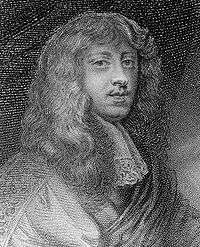Philip Stanhope, 2nd Earl of Chesterfield

Philip Stanhope, 2nd Earl of Chesterfield PC FRS (1634 – 28 January 1714) was a peer in the peerage of England.[1]
Personal life
He was the son of Henry Stanhope, Lord Stanhope and his wife, Katherine Wotton.[1] He inherited the title of Earl of Chesterfield on the death of his grandfather in 1656.[1] He was educated by Poliander, Professor of Divinity at Leyden (1640) and at the Prince of Orange's College at Breda. He received a DCL in 1669 from Oxford University.

His first marriage was to Lady Anne Percy, daughter of the Earl of Northumberland. Following her death, a marriage had been arranged between him and Mary, daughter of the 3rd Lord Fairfax. Despite the fact the banns had been read twice, Mary jilted Chesterfield for the 2nd Duke of Buckingham with whom she had fallen in love. Chesterfield subsequently married Elizabeth Butler, daughter of James Butler, 1st Duke of Ormonde and his wife, Elizabeth Preston.[1] They had one daughter, Lady Elizabeth but it is not certain that Chesterfield was the father. Elizabeth died in 1665, and he married a third time to the second daughter of Charles Dormer, 2nd Earl of Carnarvon, Lady Elizabeth Dormer, who finally provided him with two sons.[1]
According to Samuel Pepys, Chesterfield was a ladies' man, and had been one of the many lovers of Barbara Villiers, the most notorious mistress of King Charles II. His second wife, tired of his neglect, began flirting with the king's brother, the Duke of York, and also with James Hamilton.
He was imprisoned in the Tower of London for wounding Captain John Whalley in a duel (1658) and on suspicion of involvement in Sir George Booth's rising (1659). He also killed a man in a duel, fled to France, and having obtained pardon from Charles II, returned to England in his train (1660).
Career
He was Lord Chamberlain to Catherine of Braganza (1662–1665) and a member of her Council (1670). He was Colonel of a regiment of foot (1667, 1682), a Privy Councillor (1681) and the Warden of the royal forests south of Trent (1679). He was elected a Fellow of the Royal Society in November 1708.[1][2] He died at his home in Middlesex, and was buried in Shelford, Nottinghamshire.
Styles of address
- 1634: The Hon Philip Stanhope
- 1634-1656: Lord Stanhope
- 1656-1681: The Rt Hon The Earl of Chesterfield
- 1681-1708: The Rt Hon The Earl of Chesterfield PC
- 1708-1714: The Rt Hon The Earl of Chesterfield PC FRS
References
- 1 2 3 4 5 6 G. E. Cokayne; with Vicary Gibbs, H.A. Doubleday, Geoffrey H. White, Duncan Warrand and Lord Howard de Walden, editors. The Complete Peerage of England, Scotland, Ireland, Great Britain and the United Kingdom, Extant, Extinct or Dormant, new ed., 13 volumes in 14 (1910-1959; reprint in 6 volumes, Gloucester, U.K.: Alan Sutton Publishing, 2000), volume III, page 181-182; volume II, page 184.
- ↑ "Library and Archive Catalog". Royal Society. Retrieved 20 October 2010.
See also
List of deserters from James II to William of Orange
| Legal offices | ||
|---|---|---|
| Preceded by The Duke of Monmouth |
Justice in Eyre south of the Trent 1679–bef. 1686 |
Succeeded by The Earl of Huntingdon |
| Military offices | ||
| Preceded by The Earl of Mulgrave |
Colonel of The Holland Regiment 1682–1684 |
Succeeded by The Earl of Mulgrave |
| Peerage of England | ||
| Preceded by Philip Stanhope |
Earl of Chesterfield 1656–1714 |
Succeeded by Philip Stanhope |